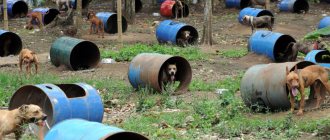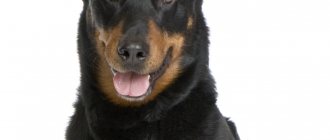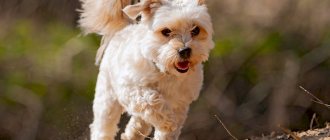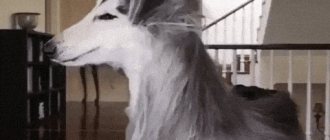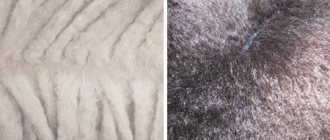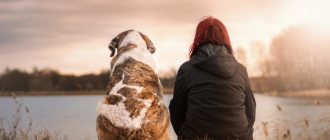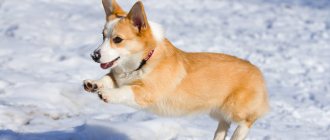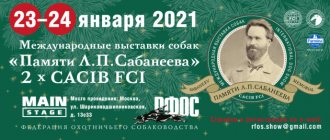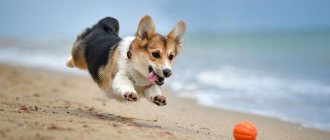The international classification of dog breeds is based on dividing animals based on their purpose. This division is very arbitrary. The same breed can, for example, be used as a guard or companion.
The FCI classification is considered the most authoritative. Most breeders focus on her. If a dog is recognized by the standards, then it is considered purebred and valuable. According to the data, all dogs are classified into one of 10 groups. Let's look at this type of classification in more detail.
Basics of taxonomy of dog breeds
When choosing an animal, future owners are guided by a certain set of characteristics that the dog must meet. These signs are most often size, specialization, and coat type. There are other details that you pay attention to before buying a pet, but they are less significant and more individual.
Konrad Laurenz theory
Groups of dogs by specialization:
- decorative - bred for people to admire and be proud of. Designer dogs have recently become popular as a separate type of decorative;
- sentinels are designed to protect the territory, to bark to notify the owner of an approaching stranger;
- servants perform some kind of service together with a person. They work in the police, in rescue services, guard borders, help blind and visually impaired people;
- hunting breeds have been valued since ancient times, helping people in hunting;
- shepherds help herd and guard livestock;
- northern sleds;
- companions exist next to a person, become true friends for him, perform the functions of nannies who can look after children or the elderly;
- fighting dogs are not used for their intended purpose; most of them are retrained as companions or used for police service.
Classification of dog breeds into groups according to coat type:
- naked;
- smooth-haired;
- short-haired;
- wire-haired;
- long-haired;
- fluffy.
Important! Even hairless dogs have a small amount of fur and need to be groomed. Not everyone knows that not only hairless dogs are hypoallergenic, but also other breeds.
Mexican hairless
Large dogs - FCI group 8
- Golden retriever
- Curly coated retriever
- Labrador Retriever
- Flat-Coated Retriever
- Chesapeake Bay Retriever
Group 8 FCI, retrievers, spaniels and water dogs.
The large dogs in this group are retrievers, that is, specialists in retrieving dead birds from the water. The coat of the Golden Retriever is the most difficult to care for - it is semi-long and abundant, and in some lines it is somewhat plump. Needs weekly brushing, and during shedding, the dog needs to be brushed daily until the coat is completely changed. The rest of the breeds are convenient because their coat is textured and short, so it is brushed no more than 2-3 times a month, with the exception of the shedding period, when brushing is carried out daily until the old hair is completely removed. These dogs are well suited for active people and are not at all universal nannies and ideal pets, as many advertising articles write about them. They are avid fetch lovers, they love to swim and feed from the water, but when bored in an apartment, they can destroy it in a very short time. A retriever is a dog that is best for families in which there is someone at home all the time. They are ideal family dogs, love children, are non-aggressive towards people and other dogs, making them suitable for large families.
Among black and brown Labradors, there are often dogs with guard behavior atypical for the breed, which makes it possible to recommend such dogs as dogs for protecting territory and people. Many retrievers work successfully in rescue services, as guide dogs, and are also used in canis therapy.
If you decide to keep a retriever in the yard of a private house, you need to communicate with it as often as possible. Constantly locked in an enclosure, this dog loses its good nature and will never become a pleasant family pet. Sufficient physical activity and constant communication with people are mandatory conditions for the successful raising and maintenance of any retriever.
International Canine Federation
How many dog breeds are there in the world: exact number
The International Cynologique Federation (FCI), better known as FCI (Fédération Cynologique Internationale), includes cynological organizations from 98 countries, including the RKF. Its main office is located in the Belgian city of Thuen. The history of the federation begins in 1911. It is engaged in:
- processing the results of international dog shows and awarding various world championship titles;
- confirmation of International Championship titles;
- regular updating of the standard of various breeds with their translation into French, German, English and Spanish;
- selection of judges who have the right to confirm the titles of international champions;
- studying and developing all international treaties, contracts and agreements;
- setting official dates on which world exhibitions of purebred dogs will be held.
Dog breeds are divided into several groups by the FCI. There are a total of 10 groups in the classification, each of which has subgroups. The FCI recognizes 349 breeds. There are the following groups of FCI dogs:
- Herding and cattle dogs, except Swiss cattle dogs.
- Pinscher, Schnauzer, Molosser, Mountain and Swiss Cattle Dogs.
- Terriers.
- Dachshunds.
- Spitz and primitive breeds.
- Hounds and related breeds.
- Cops.
- Retrievers, spaniels, water dogs.
- Decorative dogs and companion dogs.
- Greyhounds.
Some breeds are not recognized by the FCI, but are registered with the canine organization of another country. However, the FCI and the breed standards it has developed are a priority.
Dachshunds
LIST OF BREEDS FCI
Group 1 FCI (Shepherd Dogs and Cattle Dogs, except Swiss Cattle Dogs) LIST OF DOG BREEDS Group 1 FCI (in accordance with document Circular #72/1997 dated November 20, 1997): SHEPHERD DOGS and COUNTRY DOGS (without Swiss Cattle Dogs)Section 1. Shepherd dogs:
No. std.
| Breed | |
| 293 | KELPIE (Australia) |
| 15 | BELGIAN SHEPHERD DOG a) Groenendael b) Laekenois c) Malinois d) Tervuren (Belgium) |
| 83 | SCHIPPERKE a) 3-5 kg b) 5-8 kg (Belgium) |
| 332 | CZECHOSLOVAK wolfdog (Czechoslovakia) |
| 166 | GERMAN SHEPHERD (Germany) |
| 321 | PERRO DE PASTOR MALLORQUIN/CA DE BESTIAR a) shorthair b) longhair (Spain) |
| 87 | GOS D'ATURA CATALA a) longhaired b) smoothhaired (Spain) |
| 44 | FRENCH SMOOTH-HAIRED SHEPHERD DOG/Beauceron a) black and tan b) harlequin (France) |
| 113 | BRIARD a) black b) red, gray (France) |
| 176 | PICARDY SHEPHERD DOG (France) |
| 141 | PYRENEAN SHEPHERD DOG LONG-HAIRED (France) |
| 138 | PIRENEAN SHEPHERD DOG SHORT-HAIRED (France) |
| 271 | BIARDID (BEARDED) COLLIE (Great Britain) |
| 297 | BORDER COLLIE (Great Britain) |
| 156 | COLLIE LONG-HAIR (Great Britain) |
| 296 | COLLIE SHORT-HAIR (Great Britain) |
| 16 | OLD ENGLISH SHEPHERD (BOBTAIL) (Great Britain) |
| 88 | SHETLAND SHEPHERD (SHELTIE) (Great Britain) |
| 38 | WELSH CORGI CARDIGAN (Great Britain) |
| 38 | WELSH CORGI PEMBROKE (Great Britain) |
| 194 | BERGAMASKER (Italy) |
| 201 | MAREMANO-ABRUZZENE (Italy) |
| 53 | KOMONDOR (Hungary) |
| 54 | KUVAS (Hungary) |
| 238 | MOODY (Hungary) |
| 55 | PULI-HUNGARIAN WATER DOG a) white b) black, gray, red (Hungary) |
| 56 | PUMI (Hungary) |
| 223 | DUTCH SHEPHERD a) short-haired b) long-haired c) wire-haired (Netherlands) |
| 311 | SAARLOOS WOLFHOND/SAARLOOS WOLFHOOD (Netherlands) |
| 313 | CHAPENDOIS (Netherlands) |
| 251 | POLISH LOWSHIP DOG (Poland) |
| 252 | POLISH PODGALIAN SHEPHERD DOG (Poland) |
| 93 | PORTUGUESE SHEPHERD DOG (Portugal) |
| 277 | CROATIAN SHEEP DOG (Croatia) |
| 142 | SLOVAK CHUVACH (Slovakia) |
| 326 | SOUTH RUSSIAN SHEPHERD DOG (Russia) |
| 342 | AUSTRALIAN SHEPHERD (USA) |
Section 2. Cattle Dogs (except Swiss Cattle Dogs):
| 287 | AUSTRALIAN KETTLE DOG (Australia) |
| 191 | BOUVIER DE FLANDRES (Belgium/France) |
| 340 | SAINT MIGUEL SHEPHERD DOG (Portugal) |
Group 2 FCI (Pinchers and Schnauzers, Molossians and Swiss Cattle Dogs) LIST OF DOG BREEDS Group 2 FCI (in accordance with document Circular #72/1997 dated November 20, 1997): PINSCHERS AND SCHNAUZERS, MOLOSSES AND SWISS CAVE DOGS
Section 1. Pinschers and Schnauzers:
| 1.1 Pinschers | |
| 184 | PINCHER a) red-brown b) black and tan (Germany) |
| 143 | DOBERMAN a) black and tan b) brown and tan (Germany) |
| 185 | DIY PINSCHER a) red-brown b) black and tan (Germany) |
| 186 | AFFENPINSCHER (Germany) |
| 64 | AUSTRIAN SHORT-HAIRED PINSCHER (Austria) |
| 1.2 Schnauzers | |
| 181 | GIANT SCHNAUZER a) pepper and salt b) black (Germany) |
| 182 | MEDIUM SCHNAUZER a) pepper and salt b) black (Germany) |
| 183 | MINISTER SCHNAUZER a) pepper and salt b) black c) black and silver d) white (Germany) |
| 1.3 Smoushond | |
| 308 | DUTCH SMOUSHOND (Netherlands) |
| 1.4 Black Terrier | |
| 327 | RUSSIAN BLACK TERRIER (Russia) |
Section 2. Molossians:
| 292 | DOGO ARGENTINO (Argentina) |
| 225 | FILA BRAZILEIRO (Brazil) |
| 309 | SHAR-PEI (China - FCI) |
| 315 | BROHOLMER (Denmark) |
| 144 | GERMAN BOXER a) red b) brindle (Germany) |
| 235 | GREAT DANGE a) red b) brindle c) black d) harlequin e) blue (Germany |
| 147 | ROTTWEILER (Germany) |
| 249 | PERRO DOGO MALLORQUIN/CA DE BAU (Spain) |
| 116 | Dogue de Bordeaux (France) |
| 149 | ENGLISH BULLDOG (Great Britain) |
| 157 | BULLMASTIF (Great Britain) |
| 264 | MASTIF (Great Britain) |
| 197 | MASTINO NAPOLETANO (Italy) |
| 260 | TOSA INU (Japan) |
| 2.2 Mountain | |
| 331 | KOBAN KOPEZHI/ANATOLIAN SHEPHERD DOG (Anatolia - FCI) |
| 50 | NEWFOUNDLAND a) black b) brown c) white with black spots (Canada - FCI) |
| 190 | HOWAWART (Germany) |
| 145 | LEONBERGER (Germany) |
| 226 | LANDSEEER - EUROPEAN CONTINENTAL TYPE (Germany - Switzerland) |
| 91 | SPANISH MASTIF (Spain) |
| 92 | MASTIN DE LOS PIRENEOS (Spain) |
| 137 | PYRENEAN MOUNTAIN DOG (France) |
| 343 | CANE CORSO (Italy) |
| 41 | SARPLANINAC (Macedonia-Yugoslavia) |
| 247 | AIDI (ATLAS SHEPHERD DOG) (Morocco) |
| 173 | CAO DA SERRA DA ESTRELA a) smooth-haired b) long-haired (Portugal) |
| 170 | CAO DE CASTRO LABOREIRO (Portugal) |
| 96 | RAFEERO DO ALENTEIO (Portugal) |
| 61 | SAINT BERNARD (BERNARDINER) a) short-haired b) long-haired (Switzerland) |
| 278 | PAINTS OVCHAR (Slovenia) |
| 328 | CAUCASIAN SHEPHERD DOG (Russia) |
| 335 | CENTRAL ASIAN SHEPHERD DOG (Russia) |
| 230 | TIBETAN MASTIFF/DO-HI/TIBETAN DANGE (Tibet - FCI) |
Section 3. Swiss Mountain and Cattle Dogs:
| 46 | APPENZELLER SENNENHUND/APPENZELLER COUNTRY DOG (Switzerland) |
| 45 | Bernese Mountain Dog/Bernese Cattle Dog (Switzerland) |
| 47 | ENTLEBUCHER SENNENHUND/ENTLEBUCH COUNTRY DOG (Switzerland) |
| 58 | GREAT SWISS SOUNNENHUND/GREAT SWISS CAVE DOG (Switzerland) |
Group 3 FCI (Terriers) LIST OF DOG BREEDS Group 3 FCI (in accordance with document Circular #72/1997 dated November 20, 1997): TERRIERS
Section 1. Large and medium terriers:
| 341 | BRAZILIAN TERRIER (Brazil) |
| 103 | GERMAN JAGD TERRIER (Germany) |
| 7 | Airedale Terrier (Great Britain) |
| 9 | BEDLINGTON TERRIER (Great Britain) |
| 10 | BORDER TERRIER (Great Britain) |
| 12 | FOX TERRIER SMOOTH (Great Britain) |
| 169 | HAIR FOX TERRIER (Great Britain) |
| 70 | LAKELAND TERRIER (Great Britain) |
| 71 | MANCHESTER TERRIER (Great Britain) |
| 339 | PARSON JACK RUSSELL TERRIER (Great Britain) |
| 78 | WELSH TERRIER (Great Britain) |
| 302 | IRISH GLEN OF IMAAL TERRIER (Ireland) |
| 139 | IRISH TERRIER (Ireland) |
| 3 | KERRY BLUE TERRIER (Ireland) |
| 40 | IRISH SOFT COATED WHEATEN TERRIER (Ireland) |
Section 2. Small terriers:
| 8 | AUSTRALIAN TERRIER (Australia) |
| 4 | CAIRN TERRIER (Great Britain) |
| 168 | DANDY DIAMOND TERRIER (Great Britain) |
| 272 | NORFOLK TERRIER (Great Britain) |
| 72 | NORWICH TERRIER (Great Britain) |
| 73 | SCOTCH (SCOTTISH) TERRIER (Great Britain) |
| 74 | SEALYHAM TERRIER (Great Britain) |
| 75 | SKY TERRIER (Great Britain) |
| 85 | WEST HIGHLAND WHITE TERRIER (Great Britain) |
| 259 | NIHON TERRIER (JAPANESE TERRIER) (Japan) |
| 246 | CZECH TERRIER (Czech Republic) |
Section 3. Bull type:
| 11 | BULLY TERRIER a) standard b) dwarf (“miniature”) (Great Britain) |
| 76 | STAFFORDSHIRE BULL TERRIER (Great Britain) |
| 286 | AMERICAN STAFFORDSHIRE TERRIER (USA) |
Section 4. Toy Terriers:
| 236 | AUSTRALIAN SILKIE (SILKY) TERRIER (Australia) |
| 13 | ENGLISH TOY TERRIER (BLACK AND TAN) (Great Britain) |
| 86 | YORKSHIRE TERRIER (Great Britain) |
Group 4 FCI (Dachshunds) LIST OF DOG BREEDS Group 4 FCI (in accordance with document Circular #72/1997 dated November 20, 1997): DACHSHUNDS
| 148 | Standard size (Germany) a) smooth-haired b) long-haired c) wire-haired |
| 148 | Dwarf (“miniature”) (Germany) a) smooth-haired b) long-haired c) wire-haired |
| 148 | Rabbit (Germany) a) smooth-haired b) long-haired c) wire-haired |
Group 5 FCI (Northern Sled Dogs, Spitz, Primitive) LIST OF DOG BREEDS Group 5 FCI (in accordance with document Circular #72/1997 dated November 20, 1997): SPITES AND PRIMITIVES
Section 1. Northern sled dogs:
| 274 | GRÖNLANDSHUND (Greenland - Nordic Union) |
| 212 | SAMOYED DOG (SAMOYED) |
| 243 | ALASKAN MALAMUTE (USA) |
| 270 | SIBERIAN HUSKY (USA) |
Section 2. Northern hunting dogs:
| 242 | NORSC ELGHUND GRA (GRAY) (Norway) |
| 268 | NORSC ELGHUND GRADE (BLACK) (Norway) |
| 265 | NORSC LUNDEHUND (Norway) |
| 304 | RUSSIAN-EUROPEAN LAIKA (Russia) |
| 305 | EAST SIBERIAN LAIKA (Russia) |
| 306 | WEST SIBERIAN LAIKA (Russia) |
| 42 | EMTHUND (Sweden) |
| 276 | NORBOTENSPITZ (Sweden) |
| 48 | KARELIAN BEAR DOG (Finland) |
| 49 | SUOMENPISTIKORVA (FINNISH SPITCH) (Finland) |
Section 3. Northern guard and herding dogs:
| 289 | ICELAND WATCH (Iceland - Nordic Union) |
| 237 | NORWEGIAN BUKHUND (Norway) |
| 135 | SWEDISH LAPPHUND (Sweden) |
| 14 | VESTGOTASPITZ (Sweden) |
| 189 | SUOMENLAPINKOIRA (Finland) |
| 284 | LAPINPOROKOIRA (Finland) |
Section 4. European Spitz:
| 97 | GERMAN SPIEZ a) Wolf Spitz b) large c) medium d) small (“miniature”) e) dwarf (“Pomeranian”) (Germany) |
| 195 | ITALIAN VOLPINO (Italy) |
Section 5. Asian Spitz and related breeds:
| 205 | CHOW-CHOW (China - Great Britain) |
| 291 | OIRASIEER (Germany) |
| 334 | KOREAN JINDO (South Korea) |
| 255 | AKITA (Japan) |
| 261 | HOKKAIDO (Japan) |
| 317 | KAI (Japan) |
| 318 | KISHU (Japan) |
| 262 | NIHON SUPITSU (JAPANESE SPITCH) (Japan) |
| 257 | SHIBA (Japan) |
| 319 | SHIKOKU (Japan) |
Section 6. Primitive:
| 237 | CANAAN DOG (Israel) |
| 248 | PHARAHO HOUND (PHARAOH HOUND) (Malta - UK) |
| 234 | MEXICAN HAIRLESS DOG (XOLOITZCUINTLI) a) standard b) miniature (Mexico) |
| 310 | PERUAN HAIRDOWN DOG a) large b) medium c) small (Peru) |
| 43 | BASENJI (Central Africa - UK) |
Section 7. Primitive - for hunting use:
| 329 | PODENCO CANARIO (Spain) |
| 89 | PODENCO IBISENCO (Spain) |
| 199 | CIRNECO DEL ETNA (Italy) |
| 94 | PORTUGUESE PODENGO a) wire-haired b) smooth-haired (Portugal) |
Section 8. Primitive - for hunting use, with a crest on the back:
| 338 | THAI RIDGEBACK (Thailand - Japan) |
Group 6 FCI (hounds) INFORMATION ABOUT DOGS for group 6 FCI: (in accordance with document Circular #72/1997 dated 20.11.97): Hounds and RELATED BREEDS
Section 1. Hounds:
| 1.1 Large | |
| 84 | BLOODHOUND (CHIEN DE SAINT-HUBERT) (Belgium) |
| 24 | POITEVIN (France) |
| 25 | BILLY (France) |
| 219 | FRENCH TRI-COLORED HOUND (France) |
| 220 | FRENCH BLACK PIETA HOUND (France) |
| 316 | FRENCH RED SPINNED HOUND (France) |
| 322 | LARGE ENGLO-FRENCH TRI-COLORED HOUND (France) |
| 323 | LARGE ENGLISH-FRENCH BLACK-PITABLE HOUND (France) |
| 324 | LARGE ENGLO-FRENCH RED SPINNED HOUND (France) |
| 22 | LARGE BLUE GASCONY HOUND (France) |
| 21 | GRAND GASCONY SAINTONGEOIS (France) |
| 282 | GREAT GRIFFON OF VENDEE (France) |
| 159 | FOXHOUND (Great Britain) |
| 294 | OTTERHOUND (Great Britain) |
| 303 | AMERICAN FOXHOUND (USA) |
| 300 | BLACK AND TAN COONHOUND (RACOON DOG) (USA) |
| 1.2 Average | |
| 155 | BOSANSKI GONIC (FCI) |
| 204 | SOBIEO ESPANIOL (Spain) |
| 325 | ENGLO-FRENCH SHORT-TAIL HOUND (France) |
| 20 | ARIEGEOIE (France) |
| 290 | BEAGLE HARRIER (France) |
| 28 | CHIEN D'ARTOIS (France) |
| 30 | PORCELAIN (France) |
| 31 | SMALL BLUE GASCONY HOUND (France) |
| 21bis | PETTLE GASCONY SAINTONGEOIS (France) |
| 19 | VENDEE GRIFFON BRIQUET (France) |
| 32 | BLUE GASCONY GRIFFON (France) |
| 66 | BRETON RED GRIFFFON (France) |
| 17 | NIVERNESS GRIFFON (France) |
| 295 | HARRIER (UK) |
| 214 | HELLENIC IKNILATIS (Greece) |
| 151 | ISTAR SOFT-HAIRED HONER (Istria – FCI) |
| 152 | ISTAR COARSE-HAIRED HONER (Istria – FCI) |
| 337 | SHORT-HAIRED ITALIAN BRACC (Italy) |
| 198 | LONG HAIR ITALIAN BRACC (Italy) |
| 229 | YUGOSLAVAN TRI-COLORED GONICH (Yugoslavia) |
| 279 | PLANINSKI GONIC (Yugoslavia) |
| 150 | SERBIAN GONIĆ (Yugoslavia) |
| 241 | ERDELY KOPO (TRANSYLVANIA BRACK) (Hungary) |
| 203 | DUNKER (NORWEGIAN HOUND) (Norway) |
| 267 | HALDENSTEVER (Norway) |
| 266 | HIGENHUND (Norway) |
| 63 | AUSTRIAN SMOOTH HAIR BRACK (Austria) |
| 62 | STYRIAN WIREHAIR BRACK (Austria) |
| 68 | TYROLEAN BRACK (Austria) |
| 52 | POLISH OGAR (Poland) |
| 154 | POZAVSKI GONIC (Croatia) |
| 59 | SWISS HOUND (Switzerland) |
| 244 | SLOVAK KOPOV (Slovakia) |
| 51 | TRI-COLORED FINNISH HOUND (Finland) |
| 132 | HAMILTON HOUND (Sweden) |
| 131 | SCHILLER HOUND (Sweden) |
| 129 | SMOLAN HOUND (Sweden) |
| 1.3 Small | |
| 299 | GERMAN BRACK (Germany) |
| 100 | WESTPHALIAN DAXBRACK (Germany) |
| 34 | ARTESIAN-NORMAN BASSETTE (France) |
| 35 | BLUE GASCONY BASSETTE (France) |
| 18 | BASSET D'ARTOIS (France) |
| 36 | BRETON BASSETTE (France) |
| 33 | GRAND BRETON BASSET GRIFFFON (France) |
| 67 | SMALL BRETON BASSET GRIFFFON (France) |
| 163 | BASSET HOUND (Great Britain) |
| 161 | BEAGLE (UK) |
| 60 | Bernese Hound (Switzerland) |
| 130 | DREVER (Sweden) |
Section 2. Packed (hounds):
| 217 | BAVARIAN TRAIL HOUND (Germany) |
| 213 | HANOVER HOUND (Germany) |
| 254 | ALPINE DAXBAR BRACK (Austria) |
Section 3. Related breeds:
| 153 | DALMATIN (Dalmatia, Croatia - FCI) |
| 146 | RHODESIAN RIDGEBACK (South Africa - Zimbabwe) |
Group 7 FCI (coopers) INFORMATION ABOUT DOGS for group 7 FCI: (in accordance with document Circular #72/1997 dated November 20, 1997): COGER
Section 1. Continental Pointers:
| 1.1 Short-haired pointers (Bracket type) | |
| 281 | GAMMEL DANSK HONSEHUND (Denmark) |
| 119 | KURZHAAR (GERMAN SHORT-HAIRED SPOGGER) (Germany) |
| 98 | DRATHAAR (GERMAN HAIR HAIRED SPOGGER) (Germany) |
| 216 | PODEL POINTER (Germany) |
| 232 | STICHELHAAR (Germany) |
| 99 | WEIMARANER (Weimar Pointing Dog) a) short-haired b) long-haired (Germany) |
| 90 | BURGOSS POINTER (Spain) |
| 177 | ARIEGEAN BRACQUE (France) |
| 180 | Auvergne BRACQUE (France) |
| 179 | BOURBON BRACQUE (France) |
| 178 | BRACC DUPUI (France) |
| 133 | FRENCH BRACQUE - GASCONY TYPE (BIG TAIL) (France) |
| 134 | FRENCH BRACQUE - PYRENEAN TYPE (SMALL TAIL) (France) |
| 115 | SAINT-GERMAIN BRACC (France) |
| 202 | ITALIAN BRACC a) white-orange b) chestnut-roan (Italy) |
| 239 | Hungarian Wirehaired Pointer (Vizsla) (Hungary) |
| 57 | HUNGARIAN SHORT-HAIRED SPOGGER (VYZSLA) (Hungary) |
| 187 | PORTUGUESE POINTER (Portugal) |
| 320 | SLOVAK COARSE-HAIRED STAVAC (Slovakia) |
| 1.2 Spaniel type | |
| 102 | SMALL MUNSTERLANDER SPOTLIGHT (Germany) |
| 118 | GREAT MUNSTERLANDER SPOTLIGHT (Germany) |
| 117 | LANGHAAR (GERMAN LONG-HAIRED SPOGGER) (Germany) |
| 106 | BLUE PICARDIE SPANIEL (France) |
| 95 | BRETON SPANIEL a) white-orange b) other colors (France) |
| 175 | FRENCH SPANIEL (France) |
| 108 | PICARDIE SPANIEL (France) |
| 114 | PONT AUDEMER SPANIEL (France |
| 224 | DENTISH PARTRIDSHOND DOG (DUTCH PARTRIYSHOND) (Netherlands) |
| 222 | STABIHUN (Netherlands) |
| 1.3 Type of "griffons" | |
| 107 | FRENCH HAIRED POINTER GRIFFFON (France) |
| 174 | FRENCH SOFT-HAIRED POINTER GRIFFFON (France) |
| 165 | ITALIAN SPINONE a) white-orange b) chestnut-roan (Italy) |
| 245 | CZECH FOUSEK (Czech Republic) |
Section 2. British and Irish pointers and setters:
| 2.1 Pointer | |
| 1 | POYNTER (UK) |
| 2.2 Setters | |
| 2 | ENGLISH SETTER (Great Britain) |
| 6 | SETTER GORDON (SCOTTISH) (Great Britain) |
| 330 | IRISH RED AND WHITE SETTER (Ireland) |
| 120 | IRISH RED SETTER (Ireland) |
Group 8 FCI (retrievers, bird dogs, water dogs) INFORMATION ABOUT DOGS for FCI group 8: (in accordance with document Circular #72/1997 dated November 20, 1997): RETRIVERS, BIRD DOGS and WATER DOGS
Section 1. Retrievers:
| 312 | NEW SCOTIA DUCK RETRIEVER (Canada) |
| 110 | CURLY COATED RETRIEVER (Great Britain) |
| 121 | SMOOTH HAIRED RETRIEVER (Great Britain) |
| 122 | LABRADOR RETRIEVER (Great Britain) |
| 111 | GOLDEN RETRIEVER (Great Britain) |
| 263 | CHESAPEAKE BAY RETRIEVER (USA) |
Section 2. Dogs by bird:
| 104 | GERMAN QUIL DOGS (Germany) |
| 109 | CLUMBER SPANIEL (Great Britain) |
| 5 | ENGLISH COCKER SPANIEL (Great Britain) |
| 123 | FIELD SPANIEL (Great Britain) |
| 127 | SUSSEX SPANIEL (Great Britain) |
| 125 | ENGLISH SPRINGER SPANIEL (Great Britain) |
| 126 | WELSH SPRINGER SPANIEL (Great Britain) |
| 314 | KOKERHONDE (Netherlands) |
| 167 | AMERICAN COCKER SPANIEL (USA) |
Section 3. “Water” dogs:
| 105 | BARBE (France) |
| 124 | IRISH WATER SPANIEL (Ireland) |
| 221 | WETTERHOON (DUTCH WATER SPANIEL (Netherlands) |
| 37 | CAO DE AQUA (PORTUGUESE WATER DOG (Portugal) |
| 301 | AMERICAN WATER SPANIEL (USA) |
Group 9 FCI (companion dogs and toy dogs) INFORMATION ABOUT DOGS for FCI group 9: (in accordance with document Circular #72/1997 dated 11/20/97): COMPANION DOGS and TOY dogs
Section 1. Bichons and related breeds:
| 1.1 Bichons | |
| 65 | MALTESE (Central Mediterranean - Italy) |
| 250 | BICHON HAVANEZ (Western Mediterranean - Italy) |
| 215 | BICHON FRISE (CURLY BICHON) (Belgium - France) |
| 196 | BOLOGNESE (Italy) |
| 1.2 Coton de Tulo | |
| 283 | COTON DE TOULO (France) |
| 1.3 Lesser lion dog | |
| 233 | PETIT CHIANE LYON (SMALL LION DOG) (France) |
Section 2. Poodles:
| 172 | POODLE: LARGE, SMALL, Dwarf, TOY POODLE a) white b) brown c) black d) gray e) apricot (France) |
Section 3. Small Belgian dogs:
| 3.1 Griffons | |
| 81 | BELGIAN GRIFFON (Belgium) |
| 80 | BRUSSELS GRIFFON (Belgium) |
| 3.2 Petite Brabançon | |
| 82 | PETITE BRABANCON (Belgium) |
Section 4. Hairless dogs:
| 288 | CHINESE CRESTED DOG a) hairless b) powder coat with outer coat (China - Great Britain) |
Section 5. Tibetan breeds:
| 227 | LHASA APSO (Tibet - UK) |
| 208 | SHI TCU (Tibet - UK) |
| 231 | TIBETAN SPANIEL (Tibet - UK) |
| 209 | TIBETAN TERRIER (Tibet - UK) |
Section 6. Chihuahueño:
| 218 | CHIHUAHUENO a) short-haired b) long-haired (Mexico) |
Section 7. English Toy Spaniels:
| 136 | CAVALIER KING CHARLES SPANIEL a) black and tan b) ruby c) Blenheim d) tricolor (Great Britain) |
| 128 | KING CHARLES SPANIEL a) black and tan b) ruby c) Blenheim d) “Prince Charles” (tri-color) (Great Britain) |
Section 8. Japanese Chin and Pekingese:
| 207 | BEIJINGS (China - UK) |
| 206 | JAPANESE CHIN (Japan) |
Section 9. Continental Toy Spaniels:
| 77 | CONTINENTAL TOY SPANIEL a) PAPILLION b) FALEN (France - Belgium) |
Section 10. Kromforlander:
| 192 | KROMFORLANDER (Germany) |
Section 11. Small Molosser-type dogs:
| 101 | FRENCH BULLDOG a) with a limited number of spots b) with a number of spots from medium to dominant (France) |
| 253 | PUG a) red b) black c) silver d) apricot (Great Britain) |
| 140 | BOSTON TERRIER (USA) |
Group 10 FCI (greyhounds) INFORMATION ABOUT DOGS for group 10 FCI: (in accordance with document Circular #72/1997 dated 20.11.97): SIGHTHOUNDS
Section 1. Long-haired or with hanging hair:
| 228 | AFGHAN (Afghanistan - UK) |
| 269 | SALUKI (Middle East - FCI) |
| 193 | RUSSIAN HOUND SIGHTHOUND (Russia) |
Section 2. Wirehaired:
| 160 | IRISH WOLFHODW (Ireland) |
| 164 | DYHRHUND (UK) |
Section 3. Shorthair:
| 285 | GALGO ESPAÑOL (SPANISH GALGO) (Spain) |
| 158 | GREYHOUND (English greyhound) (Great Britain) |
| 162 | WHIPPET (UK) |
| 200 | Italian Greyhound Italian Greyhound (SMALL ITALIAN SIGHTHIRE) (Italy) |
| 240 | MAGYAR-AGAR (HUNGARIAN SIGHTHIRE) (Hungary) |
| 307 | AZAWAWK (Mali - France) |
| 188 | SLUGI (ARABIAN HOUND) (Morocco) |
| 333 | POLISH HART (Poland) |
Material taken from the official website of KSU www.ksu.com.ua
American Kennel Club
Ava: food for small breed dogs, holistic, premium
The American Kennel Club is a non-profit organization that maintains a registry of purebred dog breeds. It holds more than 20 thousand events annually. More than 1 million animals are registered there. The American Kennel Club identifies 7 categories of purebred dogs:
- Hunting and gun.
- Hunting.
- Service.
- Terriers.
- Indoor decorative.
- Non-hunting.
- Shepherds.
Important! There is a special register in which breeders working on the creation of new dog breeds can record the pedigrees and litters of animals for their subsequent official registration.
English Kennel Club
Purina food for dogs of small and large breeds
The English Kennel Club is a British organization that registers all purebred dogs and breeds. This club has identified the following groups of dog breeds:
- Hunting.
- Arms.
- Terriers.
- Custom.
- Service.
- Indoor decorative dogs.
- Shepherds.
Interesting! The English Club recognizes 218 dog breeds, 60 of which are British. From 04/06/2016 in Britain, the owner is obliged to ensure that the animal is compulsorily microchipped and enter it into the register of one of the commercial databases.
Chipping a dog
Large dogs - FCI group 3
- Airedale
The third group of FCIs are terriers.
The third group of the FCI boasts a single large breed - the Airedale Terrier. This is a wire-haired, very active dog, capable of either lying next to its owner on the sofa or being an assistant to a hunter or policeman. It is distinguished by the absence of odor, the need for regular trimming and training - the Airedale Terrier is still one of the service breeds and can successfully pass both hunting and other tests, work as a rescuer, engage in agility or transport heavy loads. One of the distinguishing features of the terrier is its independent nature - training this dog will require patience and perseverance from the owner.
Herding and cattle dogs, except Swiss cattle dogs
From the name of the group it is clear who is included in this category, which is officially recognized by the IFF. Most often, the name of the breed contains the name of the area in which the breed was bred. These animals are endowed with a herding instinct that is inherited. They are endowed with the qualities of guarding and shepherding the flock. These are large, strong, calm animals with great patience.
Continental Cops
The main difference from the others is the ability to make a stand in front of other animals that they hunt. They are used for hunting birds and small game. Able to follow the trail of a victim.
Short-haired pointers (Bracket type)
The breeding of these breeds was mainly carried out in Germany under the guidance of professional hunters. The main requirement for them is the ability to perform absolutely any job while hunting. They are actually capable of everything, although not very well.
Important! Animals of this group are not suitable for keeping in an apartment, they need space and fresh air, and regular walking on a leash is not enough for them.
Spaniel type
Spaniels are hunting dogs that are designed to catch medium-sized game. They are only capable of land hunting. Spaniels are distinguished by intelligence, the ability to think quickly and make the right decisions, high mobility and productivity. Spaniels have long been used as pets that do not go hunting with their owner.
Boykin Spaniel
Swiss cattle dogs
This subgroup unites only four breeds, whose homeland is Switzerland. Their feature is their large size, calmness, ability to do even hard work, devotion, and ability to serve people.
Interesting! At the very beginning of their appearance, these animals were used as sleds: they transported carts of cheese from one Swiss village to another.
Large dogs - FCI group 7
- English pointer
- English Setter
- Weimaraner
- Hungarian Wirehaired Pointer
- Hungarian Shorthaired Pointer
- Irish Red Setter
- Italian marriage
- German Shorthaired Pointer (Kurzhaar)
- German Wirehaired Pointer (Drathaar)
- German Longhaired Pointing Dog (Langhaar)
- Scottish Setter
FCI group 7. Cops.
This includes continental and island (Irish and British) pointers. Among them there is not a single dog with rich hair, as this would create inconvenience during the hunt.
Shorthair breeds
These include the English Pointer, Weimaraner, Hungarian Shorthaired Pointer, Italian Braque, Shorthaired Pointer or German Shorthaired Pointer. Excellent companions not only for the hunter, but also for the athlete. Very attentive to people, loyal to other dogs, they are able to freeze in a picturesque stance at the sight of a bird. Well suited for city apartments, despite their size. They are absolutely happy if the owner is a hunter, but they do not agree with regular long walks in the city or outside the city, swimming, presenting objects from the water and agility.
Long-haired breeds
These are, for example, English, Irish and Scottish setters, long-haired German pointers - breeds with soft fur that are easy to care for. It is combed only if burrs are found; normally it cleans itself and looks great if the dog is fed properly. These dogs also require extensive exercise and close contact with the owner. They are avid fetchers, which is successfully used by athletes when teaching them various sports. Despite the long coat, in a private home in winter they should be kept in heated rooms.
Wire-haired breeds
These are Hungarian and German wirehaired pointers. They do not shed, provided that the owner plucks off old dead, coarse hair 2-3 times a year. In regions with mild winters, they can live outside all year round, and they protect the territory well, barking impressively at guests with bass. Activity requirements are similar to other cops.
Schnauzer
This is a group of dogs with a universal purpose. Unites three breeds: miniature schnauzer, miniature schnauzer, and giant schnauzer. Distinctive features:
- square build;
- large, prominent head with a beard and bushy eyebrows;
- hard wool.
Schnauzers are endowed with high intelligence and learn quickly. They are excellent watchdogs and companions. But those who are not ready to lead an active lifestyle should not get them, since these dogs need long, active walks in the fresh air.
Schnauzer
Large dogs - group 10
- Afghan Hound
- Greyhound
- Irish Wolfhound
- Russian greyhound
- Scottish Deerhound
FCI group 10, greyhounds.
Group 10 includes a number of large, fleet-footed dogs, of which the Afghan Hound is the most difficult to care for. Some lines of Russian greyhounds, bred exclusively for exhibitions, come close to this - they are distinguished by a more abundant coat than that of working dogs. These dogs require regular brushing and washing using special cosmetics for long-haired dogs. The fur on the paws and ears is hidden in special covers for safety.
The Irish Wolfhound and Deerhound are both wire-haired greyhounds that require little grooming. As they age, the coarse fur can easily be pinched off by hand or removed with a furminator. The rest of the time, these dogs do not shed hair around the house and are large, but very comfortable residents of city apartments. They are balanced and do not require long runs in the field, since they do not have much endurance or longevity. At the same time, the Deerhound needs movement more, since it has only recently ceased to be used in deer hunting. In a private home, both breeds require winter keeping in insulated rooms.
Short-haired greyhounds such as the Greyhound, Azawakh, Spanish Galgo, Hungarian Agar, Polish Hart and Slugi are the easiest to care for. However, they are the ones who need running - their native element is the field. Special competitions have been developed for dogs of these breeds - they catch up with a mechanical hare or participate in races. Recently, some agility athletes have begun to try greyhounds in this sport. Despite their short hair, greyhounds cannot be called dogs for beginners - their love of running causes a lot of trouble for novice owners and must be regularly satisfied by participating in competitions or long walks, running behind a bicycle or horse.
Molossians
Molossians include:
- herding dogs;
- mastiff dogs;
- herd dogs.
Their main characteristics are powerful, muscular bodies and equally powerful jaws. They are incredibly hardy and have high immunity.
Attention! Molossians are difficult to train dogs that are willful and disobedient. Despite all this, they are very smart. Training should begin from puppyhood.
South African Boerboel
Pinschers and Schnauzers, Molossians and Swiss Mountain and Cattle Dogs
These breeds are grouped into one category because they share common traits. They are connected by both biology (appearance and body structure), and geography - all recognized by the breed standard are Europeans - and common character traits. These are devotion, dedication, determination, high intelligence, and the ability to perform many functions.
Mountain dogs
Mountain dogs are a subgroup of Molossians. They are distinguished by their ancient origin and centuries-long service to man. These are wonderful guards and shepherds. Externally, they are distinguished by their large size, thick coat with dense undercoat, and high immunity.
What groups are dogs divided into based on appearance and use?
There are several classifications based on use. The most common is American. She distinguishes:
- hunting gun dogs;
- a separate genus of hunting dogs;
- working dogs;
- terriers;
- room and decorative;
- non-sports;
- shepherds
Classification by conformation is based on the idea that the form and function of a dog are interconnected, appearance is directly related to temperament and essence. There are many different authors, biologists and dog breeders who study this issue, classifying dogs into families and classes. This is one of the most difficult definitions.
Advice! To maintain excellent appearance and stay healthy, all dogs need to take vitamins.
Classification by size
Depending on their size, there are groups of dogs:
- dwarf (up to 30 cm at the withers, weight up to 4 kg);
- small (height at withers up to 40 cm, weight up to 10 kg);
- medium (height 40-55 cm, maximum weight 25 kg);
- large (55-75 cm at the withers, 26-50 kg weight);
- gigantic (height more than 75 cm and weight more than 50 kg).
There are many dog classifications, which is not surprising. After all, for true breeders, dogs are a separate kingdom. For ordinary people who want to have a four-legged pet, its class and relation to one category or another will not be so important. A dog is loved not because it belongs to one of the families, not because of its age, weight, or other parameters, but simply because it exists, that it is always nearby.
Exhibition-certificate.
This table makes it possible to see at what rank exhibitions (CAC, CRF, Black Sea Fleet, CACIB) you can get this or that certificate.
| Black Sea Fleet | CHRKF | CACIB | ||||||
| BOS | CW | JBOB | BOS | CW | JBOB | BOS | CW | JBOB |
| CACIB | ||||||||
| CAC | ||||||||
| Black Sea Fleet | ||||||||
| CHRKF | ||||||||
| JCAC | ||||||||
| YuChF | ||||||||
| YuChRKF | ||||||||
BOS - Best male, best female
CW - Class Winner
JBOB - Junior class winner.
* For the decoding of certificates (CAC, Black Sea Fleet, ChRKF, JCAC, etc.), see the next section.
** VRKF Certificates (RKF Veteran Champion), VCAC, etc. are awarded similarly to Junior certificates.
*** Exhibitions whose rank is designated CAC gr [n] are held only for dogs of the designated group, certificates are awarded as for an exhibition of the Black Sea Fleet rank.

